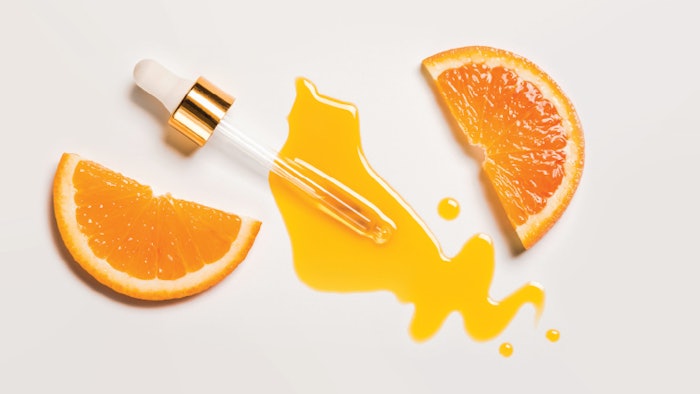
Read more in the September digital magazine...
Vitamin C, also known as L-ascorbic acid (LAA), is one of the most commonly used ingredients in the cosmetics industry. It is included in various topical formulations due to its proven efficacy in targeting the signs of aging, antioxidant support and brightening effects. However, its reputation as a “jack-of-all-trades” does come with some drawbacks, as LAA is unstable and readily prone to dissociation or oxidation in the presence of light, oxygen, alkali, heavy metals, high temperatures and copper. Its structure and subsequent hydrophilicity also does not allow for optimal skin delivery.1, 2 These drawbacks have given rise to the synthesis of various vitamin C derivatives that provide effects comparable to those of LAA, with improved stability and skin permeability.1
Ethyl ascorbic acid (EAA), also known as 3-O-ethyl-L-ascorbic acid, is one of the many derivatives of LAA available. 3-O-alkylascorbic acids were first prepared in the early 1990s by Nihro, et al. to evaluate their antioxidant activity, and for the purpose of treating reperfusion disturbances after certain coronary procedures.3 EAA has since been observed to be a strong chain-breaking antioxidant with high affinity for biomembranes, while offering a better stability profile than LAA, making it a promising derivative for various applications—both therapeutic and cosmetic.4 EAA’s antioxidant activity has also been observed to be more prolonged than LAA in cultured fibroblasts.5
While EAA stability is dependent on pH, temperature, base of the formulation and the solvents used,5, 6 its performance in aqueous solutions is superior to that of LAA, and when applied topically, EAA has yielded similar effects to those of LAA, including: collagen support (and subsequent reduction of fine lines and wrinkles), improvement of uneven pigmentation and antioxidant protection against free radicals.7 These multiple benefits make it a valuable vitamin C derivative for cosmetic applications...
Continue reading in the September issue...
References
- Zerbinati, N., Sommatis, ... Mocchi, R., et al. (2021). The anti-aging and whitening potential of a cosmetic serum containing 3-o-ethyl-l-ascorbic acid. Life 11(5) p 406.
- Chen, S.-J., Hseu, Y.-C., ... Yang, H.-L., et al. (2021). The anti-melanogenic effects of 3-O-ethyl ascorbic acid via Nrf2-mediated α-MSH inhibition in UVA-irradiated keratinocytes and autophagy induction in melanocytes. Free Radical Biology and Medicine 173 151-169; available at https://doi.org/10.1016/j.freeradbiomed.2021.07.030.
- Nihro, Y., Sogawa, S., ... Satoh, T., et al. (1992). 3-O-alkylascorbic acids as free radical quenchers. 3. Protective effect on coronary occlusion-reperfusion induced arrhythmias in anesthetized rats. J Medicinal Chem 35(9) 1618-1623.
- Stamford, N.P. (2012). Stability, transdermal penetration, and cutaneous effects of ascorbic acid and its derivatives. J Cos Derm 11(4) 310-317.
- Enescu, C.D., Bedford, L.M., Potts, G. and Fahs, F. (2022). A review of topical vitamin C derivatives and their efficacy. J Cos Derm 21(6) 2349-2359.
- Golonka, I., Oleksy, M., Junka, A., Matera-Witkiewicz, A., Bartoszewicz, M. and Musiał, W. (2017). Selected physicochemical and biological properties of ethyl ascorbic acid compared to ascorbic acid. Biological and Pharmaceutical Bulletin 40(8) 1199-1206.
- Wathoni, N. (2012). Effect of iontophoresis and propylene glycol on the in vitro diffusion of ethyl vitamin C cream. Intl Res J Pharma and Applied Sci 2(4) 31-34.











